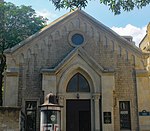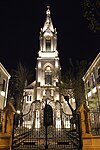Baku railway station
Asian railway station stubsBuildings and structures in BakuRailway stations in AzerbaijanRailway stations opened in 1880Transport in Baku

Baku railway station (Azerbaijani: Bakı Dəmir Yolu Vağzalı) is the central station of Baku, the capital of Azerbaijan. It is located in the Nesimi district in central Baku, approximately 3 km northeast from the historical core of Baku, İçərişəhər. It is connected to the adjacent 28 May metro station by a pedestrian tunnel. It is also the terminal of the circular Baku suburban railway.
Excerpt from the Wikipedia article Baku railway station (License: CC BY-SA 3.0, Authors, Images).Baku railway station
Shah Ismail Khatai avenue, Baku City
Geographical coordinates (GPS) Address Nearby Places Show on map
Geographical coordinates (GPS)
| Latitude | Longitude |
|---|---|
| N 40.383055555556 ° | E 49.853333333333 ° |
Address
Xətai prospekti
Shah Ismail Khatai avenue
1008 Baku City (Nasimi Raion)
Baku, Azerbaijan
Open on Google Maps







